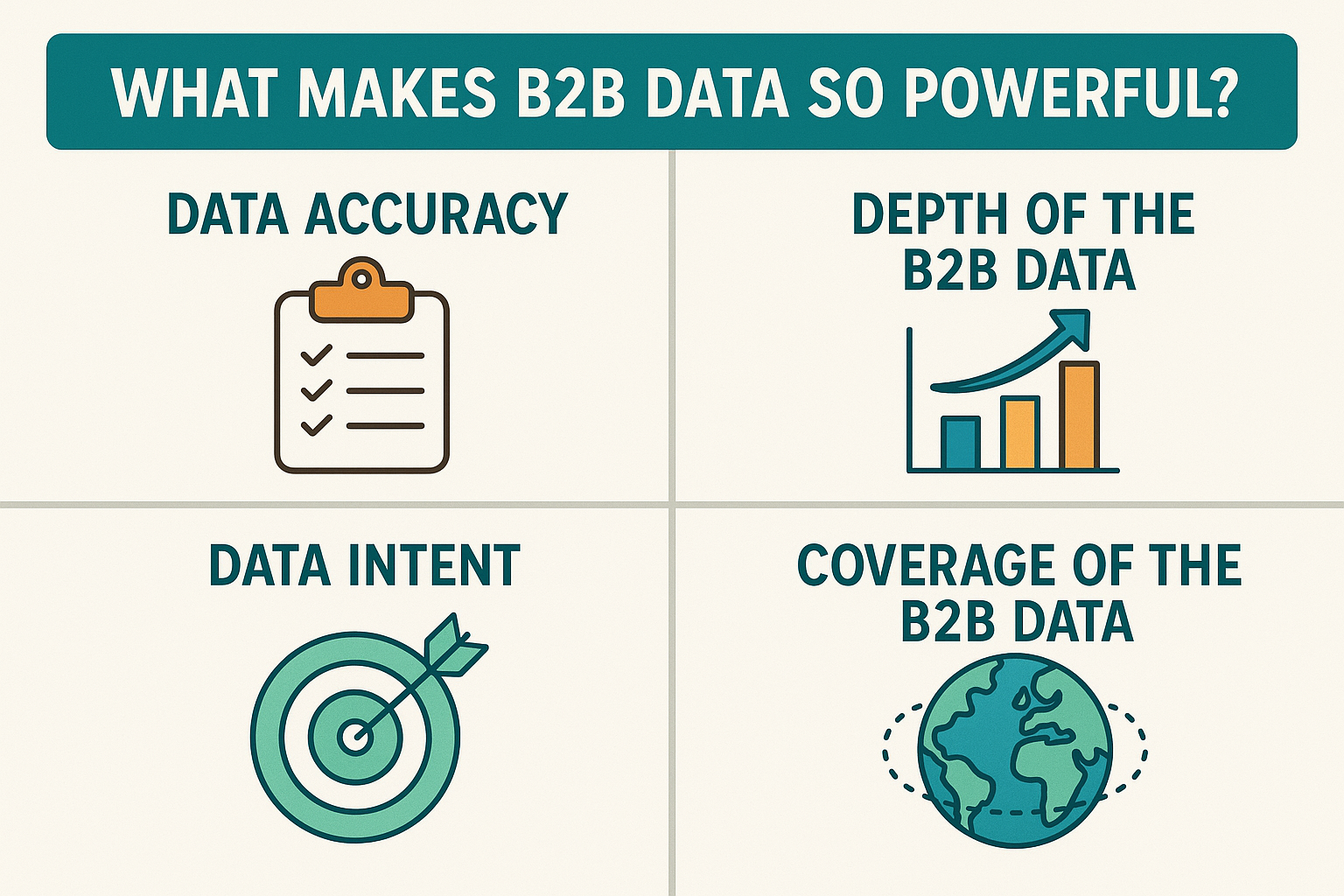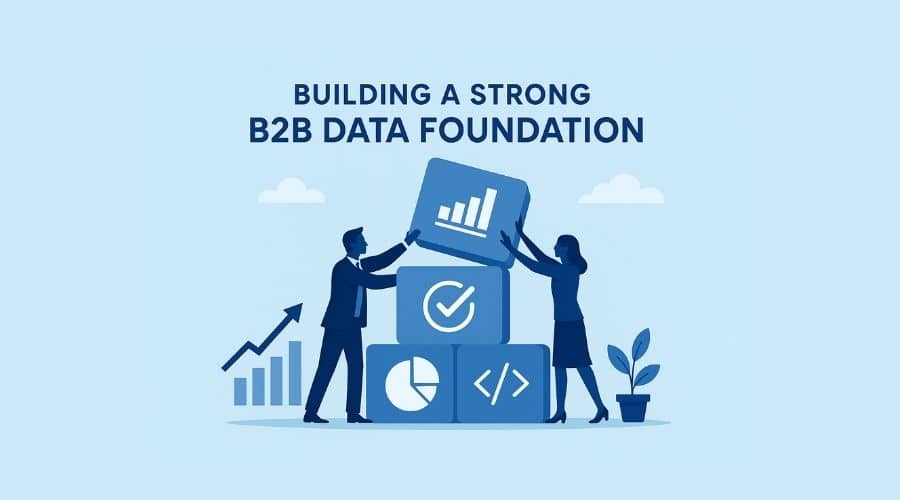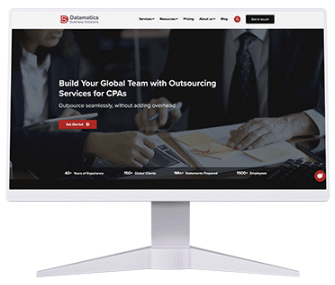In today’s fast-paced business world, gut instinct and guesswork no longer cut it. In a study by Gartner, 77% of B2B buyers stated that their last purchase was complex or difficult. The need for precision, personalization, and insight has never been greater. And at the heart of that capability lies one powerful asset: data.
B2B data is no longer just a support function. It is the foundation for every meaningful growth initiative. Whether you are designing highly targeted campaigns, training AI models to predict buyer behavior, or optimizing the sales pipeline, data is what brings clarity and direction. According to McKinsey, data-driven organizations are 23 times more likely to acquire customers, 6 times more likely to retain them, and 19 times more likely to be profitable.
For business leaders navigating this complex and evolving landscape, understanding how B2B data fuels business growth isn’t optional anymore. It is a strategic imperative.
Why B2B Data Matters More Than Ever?
The average B2B purchase decision involves 6 to 10 decision-makers. Each of them is armed with independently gathered information. This makes navigating a buying journey anything but linear. These long and complex cycles that often span several months create a landscape where assumptions are costly, and delays are common.
In this high-stakes environment, having the right B2B data allows you to:
- Identify the right accounts to target:
According to Demand Gen Report, 83% of B2B marketers say ABM (Account-Based Marketing) delivers higher ROI than traditional strategies. But it is only possible with accurate firmographic and intent data.
- Understand decision-makers within those accounts:
Data helps map the buying committee, surfacing roles, influence levels, and digital body language. This is crucial in deals where sales cycles are 22% longer than 5 years ago.
- Personalize messaging to match their stage in the buying journey:
Research by Epsilon shows that 80% of buyers are more likely to engage with a company that offers personalized experiences.
- Spot trends and gaps across segments:
B2B data enables real-time segmentation by vertical, location, and behavior. This helps improve targeting accuracy and uncover underserved markets.
- Align marketing and sales with shared insights:
Companies with tightly aligned sales and marketing teams see 36% higher customer retention and 38% higher sales win rates, said a report by MarketingProfs.
In short, B2B data gives you the clarity to act, rather than guess. It reduces wasted effort, uncovers hidden opportunities, and ensures your go-to-market strategies are built around real buyer behavior. Not just assumptions.
 Select an element to maximize. Press ESC to cancel.
Select an element to maximize. Press ESC to cancel.The Foundation of Modern Marketing and Sales
Imagine launching a campaign without knowing who you’re speaking to. Or say building a sales pipeline based on outdated contacts. That is what happens when data is missing or inaccurate.
B2B data supports the entire go-to-market engine:
- Campaigns: Helps identify who to target, what to say, and when to say it
- AI-Driven Insights: Powers everything from predictive lead scoring to automated personalization and next-best-action suggestions
- Segmentation: Enables more relevant messaging across verticals, geos, and company sizes
- Lead Scoring: Prioritizes outreach based on intent and fit
- Sales Enablement: Gives teams visibility into account hierarchies, pain points, and recent activity
Without this data, even the most creative marketing ideas can fall flat. Good storytelling only works when it is backed by good signals. And to be honest. 85% of marketing campaigns fail because of poor data quality.
What Makes B2B Data So Powerful?
It’s not just about having a lot of information. It’s about having the right kind. Here’s what separates useful B2B data from noise.
 Select an element to maximize. Press ESC to cancel.
Select an element to maximize. Press ESC to cancel.
Data Accuracy
Outdated or incorrect data—whether it’s email addresses, company size, or job titles—can drain your budget and demoralize your team. Imagine SDRs chasing leads that no longer exist or campaigns bouncing because contacts have moved on.
Bad data wastes time, money, and opportunity. According to Experian, 91% of companies suffer from common data errors like duplicates, outdated information, or incomplete records. Accuracy ensures your team works with information they can trust.
 Select an element to maximize. Press ESC to cancel.
Select an element to maximize. Press ESC to cancel.Depth of the B2B Data
Surface-level data like names and emails is no longer enough. What truly drives smart marketing is deep context. It is all about knowing a company’s tech stack, recent funding rounds, open job roles, or mergers and acquisitions.
These indicators help sales and marketing teams understand where the company is on its growth journey and what solutions might resonate with your target audience. Depth turns generic outreach into meaningful conversations and opens the door to more strategic account targeting.
Data Intent
It’s not just about who a prospect is. It is about what they are doing. Intent data reveals which companies are actively researching topics related to your product or service. This allows your team to strike while interest is high, reducing the time from awareness to engagement.
G2 in a study shows that companies using intent signals can see up to 2x increase in pipeline conversion rates. It is the difference between cold outreach and well-timed, relevant engageme
Coverage of the B2B Data
You need a wide-angle lens to see the full market opportunity. A robust B2B data solution should cover both large enterprise accounts and smaller, niche players—across geographies, industries, and languages. Limited data coverage means limited growth. Whether you’re expanding into new regions or verticals, comprehensive coverage ensures you’re not flying blind. It is also vital for global teams running regional campaigns that require localized intelligence.
The best B2B data combines these factors to give you a clearer picture of your market. It helps businesses connect the dots between what customers need and what you offer.
 Select an element to maximize. Press ESC to cancel.
Select an element to maximize. Press ESC to cancel.B2B Data and AI: A Two-Way Relationship
AI is no magic wand. It can sift through billions of data points in seconds, but what it produces is only as smart as what it is fed. Poor input equals poor output – every time. Without high-quality, structured B2B data, even the most sophisticated machine learning algorithms will underperform. Or even worse, lead you down the wrong path.
Think of AI like a high-performance engine. B2B data is the fuel. If that fuel is contaminated, the engine will misfire. So missing fields, outdated contacts, or incomplete firmographics can be more harmful than you understand.
When powered by clean, enriched, and structured data, AI tools unlock incredible value across the marketing and sales ecosystem. For instance:
- Recommend the Next Best Action:
AI can analyze patterns in prospect behavior, like content consumption, email opens, and meeting history to suggest timely follow-ups and the most relevant messaging for sales reps.
- Predict Account Conversions:
AI models can evaluate thousands of attributes such as past engagement, technographics, industry trends, and firm size to score leads and identify which accounts are more likely to close.
- Hyper-Segment Audiences:
AI helps you break down your audience beyond typical firmographic filters. It can group buyers based on behavior, pain points, or even predicted intent fueling highly personalized campaigns at scale.
- Real-Time Campaign Optimization:
AI continuously monitors campaign performance and offers insights like when to send emails, which CTAs are working, or which ad variants are underperforming, allowing marketers to course-correct fast.
But it doesn’t stop there.
AI is also playing a growing role in data hygiene and governance. It can automatically:
- Detect and merge duplicate records across systems
- Validate contact details and job roles using external sources
- Enrich missing fields with real-time data
- Flag anomalies or inconsistencies in CRM entries
This creates a feedback loop where clean B2B data improves AI outcomes, and AI, in turn, helps ensure that data stays fresh, accurate, and actionable.
As organizations rely more on predictive analytics, personalization, and automation, the symbiotic relationship between data and AI becomes a major competitive advantage. Businesses that invest in both clean data and smart tools gain a clearer view of their market, better anticipate buyer needs, and execute with precision.
 Select an element to maximize. Press ESC to cancel.
Select an element to maximize. Press ESC to cancel.Real-World Growth Outcomes from B2B Data
Let’s look at a few tangible ways businesses have used B2B data to drive measurable growth:
- Improved conversion rates:
By targeting accounts showing high intent, companies have seen better lead-to-opportunity ratios.
- Shorter sales cycles:
When sales reps know exactly who they’re speaking to, discovery calls are sharper and more productive.
- Increased pipeline value:
With deeper segmentation, businesses can create more tailored offers, improving the average deal size.
- Market expansion:
Access to international firmographics and account intelligence helps identify untapped regions or industries.
These aren’t hypothetical benefits. These are outcomes rooted in better data strategies.
You can also read: What is B2B Data Management and Why Should Businesses Prioritize It?
 Select an element to maximize. Press ESC to cancel.
Select an element to maximize. Press ESC to cancel. Select an element to maximize. Press ESC to cancel.
Select an element to maximize. Press ESC to cancel. Select an element to maximize. Press ESC to cancel.
Select an element to maximize. Press ESC to cancel. Select an element to maximize. Press ESC to cancel.
Select an element to maximize. Press ESC to cancel. Select an element to maximize. Press ESC to cancel.
Select an element to maximize. Press ESC to cancel. Select an element to maximize. Press ESC to cancel.
Select an element to maximize. Press ESC to cancel. Select an element to maximize. Press ESC to cancel.
Select an element to maximize. Press ESC to cancel. Select an element to maximize. Press ESC to cancel.
Select an element to maximize. Press ESC to cancel. Select an element to maximize. Press ESC to cancel.
Select an element to maximize. Press ESC to cancel. Select an element to maximize. Press ESC to cancel.
Select an element to maximize. Press ESC to cancel. Select an element to maximize. Press ESC to cancel.
Select an element to maximize. Press ESC to cancel. Select an element to maximize. Press ESC to cancel.
Select an element to maximize. Press ESC to cancel. Select an element to maximize. Press ESC to cancel.
Select an element to maximize. Press ESC to cancel. Select an element to maximize. Press ESC to cancel.
Select an element to maximize. Press ESC to cancel. Select an element to maximize. Press ESC to cancel.
Select an element to maximize. Press ESC to cancel.How to Build a Strong B2B Data Foundation?
If you’re a business leader looking to turn data into real growth, it starts with building a smart, scalable, and sustainable data foundation. That doesn’t mean collecting as much data as possible. It means collecting the right data and using it the right way. Here are the core components to focus on:

Start with Quality, Not Quantity
More isn’t always better. A massive database might look impressive. But if it is filled with outdated, irrelevant, or duplicate contacts, it becomes a liability rather than an asset. In fact, bad data costs U.S. businesses over $3 trillion annually (Harvard Business Review).
A smaller, well-maintained database that’s accurate and up-to-date will consistently outperform a bloated one. It’s better to have 5,000 contacts you truly understand than 50,000 that offer no insight.
 Select an element to maximize. Press ESC to cancel.
Select an element to maximize. Press ESC to cancel.Invest in B2B Data Enrichment
Your CRM might have names and emails. But what about intent data? Company tech stack? Or recent funding rounds? B2B Data enrichment layers provide depth and context, allowing you to craft campaigns that actually resonate.
For instance, knowing a company is hiring for DevOps roles or just switched to a cloud-native platform gives you a serious edge when positioning your solution. B2B data enrichment turns basic contact info into market intelligence.
Segment Strategically
Gone are the days of generic “industry + company size” segmentation. Today’s most effective marketers segment audiences using multiple variables: behavior, buying stage, tech usage, revenue signals, even language preferences.
The more precise your segmentation, the more relevant your messaging. This also improves your chances of engagement. B2B data providers like Datamatics Business Solutions leverage AI and intent data to automate much of this, allowing you to scale personalization without burning out your team.
Refresh Your B2B Data Regularly
Data decays faster than you think. About 30% of B2B data becomes outdated every year, according to Dun & Bradstreet. People switch jobs, companies pivot, and new contacts enter the picture daily. If you’re not cleansing your database on a regular basis, your campaigns could be missing the mark entirely.
Build routines for deduplication, validation, and refreshing key fields to keep your data working for you, not against you.
Bridge Marketing and Sales
Siloed teams lead to siloed data—and missed opportunities. When marketing and sales operate with different views of the same account, alignment falls apart. Create shared dashboards, sync CRMs with marketing automation tools, and ensure both teams have access to the same insights. Unified data visibility builds trust, helps prioritize the right accounts, and ensures both teams are working toward the same revenue goals.
Think of B2B Data as a Living Asset
A strong data foundation isn’t a one-time implementation—it’s an evolving strategy. As your market changes, your buyer personas shift, and your products evolve, so should your data. Establish internal ownership (or a partner) responsible for governance, quality, and ongoing enrichment. Businesses that treat data as a living asset—not just a list—are the ones who ultimately grow faster, connect better, and close smarter.
Building a strong B2B data foundation isn’t a one-time activity. It’s an ongoing process that evolves with your business.
The Competitive Edge of a Data-First Approach
In competitive industries, small advantages compound quickly. Having a clearer picture of your market, buyers, and timing can be the difference between getting the deal and missing out. B2B data arms you with clarity.
It also helps you move with confidence. Instead of reactive decision-making, your teams can plan with a sharper sense of direction.
And in a world where every click, call, and conversation generates new information, the companies that turn that data into action will be the ones that grow faster, smarter, and more sustainably.
Why Datamatics for B2B Data?
The quality of your data can make or break your go-to-market strategy. That is where Datamatics stands out. We don’t just deliver data. We deliver intelligence. With access to 230+ million global business records and a deep understanding of firmographics, technographics, and intent signals, we help you target the right accounts with confidence. Whether you’re launching an ABM campaign, building a pipeline, or feeding AI models, our data solutions are designed to fuel results.
What makes us different is the way we blend AI-powered processing with human expertise. We cleanse, enrich, and build data tailored to your specific ICP, ensuring it’s accurate, current, and highly actionable. And we do it at scale. From Fortune 500s to fast-growing SaaS firms, leading enterprises trust us to keep their CRMs clean, compliant, and campaign-ready.
Final Thought
Data isn’t just the edge. It’s the engine. And in today’s world, the winners aren’t those who guess the best. They are the ones who know the most, move the fastest, and personalize at scale. Every successful campaign, every AI insight, every sales win has data at its root.
In a market where complexity and competition keep rising, clarity is your advantage. When your business is powered by precise, relevant, and actionable B2B data, you replace uncertainty with insight, and hope with strategy.
The bottom line? Growth belongs to those who treat data as a living, strategic asset, not an afterthought. Choose intelligence over instinct, accuracy over assumption, and let your data do the heavy lifting. The future of business is data-first. Make sure you’re not left guessing.
If you are looking for B2B data that works for you, Datamatics will be able to help you. Get in touch with our experts and see how we can help your business navigate the date woes.
Like what you read? Subscribe to our blogs and stay ahead the curve.

James Libera

